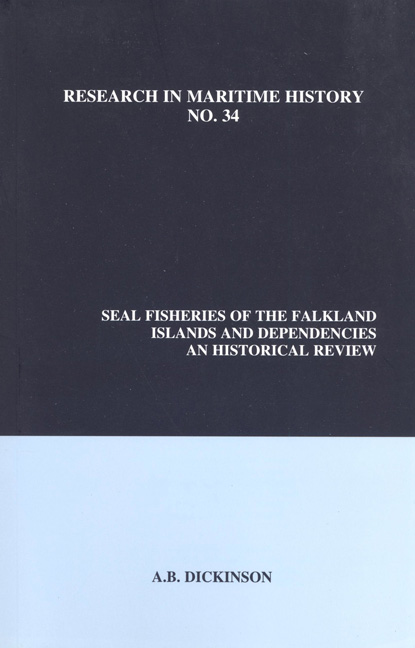Book contents
- Frontmatter
- map
- Contents
- List of Tables in the Text
- List of Illustrations
- About the Author
- Chapter 1 Introduction
- Chapter 2 Unregulated Sealing in the Falkland Islands
- Chapter 3 The Development of a Regulated Industry
- Chapter 4 Unregulated Sealing in the Dependencies
- Chapter 5 Regulated Sealing in the Falkland Islands, 1881-1914
- Chapter 6 Pelagic Sealing
- Chapter 7 Twentieth-Century Sealing on the Falkland Islands
- Chapter 8 Controlled Sealing at South Georgia
- Chapter 9 Aftermath
- Appendices 1-8
Chapter 2 - Unregulated Sealing in the Falkland Islands
- Frontmatter
- map
- Contents
- List of Tables in the Text
- List of Illustrations
- About the Author
- Chapter 1 Introduction
- Chapter 2 Unregulated Sealing in the Falkland Islands
- Chapter 3 The Development of a Regulated Industry
- Chapter 4 Unregulated Sealing in the Dependencies
- Chapter 5 Regulated Sealing in the Falkland Islands, 1881-1914
- Chapter 6 Pelagic Sealing
- Chapter 7 Twentieth-Century Sealing on the Falkland Islands
- Chapter 8 Controlled Sealing at South Georgia
- Chapter 9 Aftermath
- Appendices 1-8
Summary
Early voyagers to the Cape Horn region often described the environments and species they encountered. George Anson commented on the behaviour of southern elephant seals, which he identified as “sea lions,” and John Byron described the beaches of Port Egmont and Saunders Island as crowded with fur seals. He also took “sea lions” to replenish his oil supplies (see figure 2.1). The importance of the Falkland Islands as a potential centre for whaling and sealing was also pointed out by Lieut. Samuel Clayton after his appointment on 1 March 1773 to administer the islands from Port Egmont. Others remained unconvinced, arguing that the islands would only be used for various lawless activities.
The beginnings of commercial sealing on the Falklands coincided with the spread of American and British whaling to the region. Since many vessels combined both activities, sealing was influenced by the same political and economic conditions that affected whaling. Inshore whaling by settlers in coastal New England evolved into an offshore industry by around 1713 as they depleted more accessible stocks of the north Atlantic right whale, Eubalaena glacialis. Oil could now be produced at sea in try-works on board, and longer voyages were possible. As a result, American whalers entered the southern hemisphere from 1763. At least ten vessels arrived at the Falkland Islands in 1774 and obtained full cargoes of oil in six to eight weeks. Seals probably contributed substantially to this quick success.
Meanwhile, the British southern whale fishery was developing out of Greenland whaling, which had become established in 1759 after the British government introduced vessel tonnage bounties and fishing premiums to encourage the industry's expansion. British whalers arrived at the Falkland Islands around 1776 after the northern hemisphere bounties were extended to the southern hemisphere, including for the “oil of other creatures living in the seas.” At least twenty-five vessels averaging 165 tons each left London for southern whaling in 1776-1777 and may have filled up on seal oil.
The first American sealing vessels to arrive at the Falklands may have been Montague (Capt. Gamaliel Collins) from Boston and Thomas (Capt. David Smith) from Truro on Cape Cod.
- Type
- Chapter
- Information
- Seal Fisheries of the Falkland Islands and DependenciesAn Historical Review, pp. 25 - 42Publisher: Liverpool University PressPrint publication year: 2007



